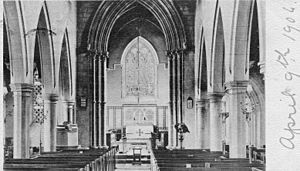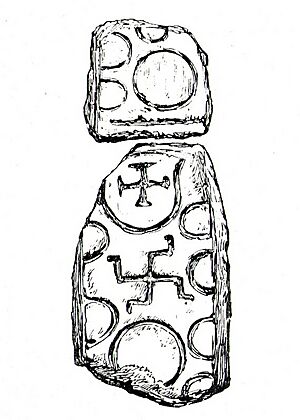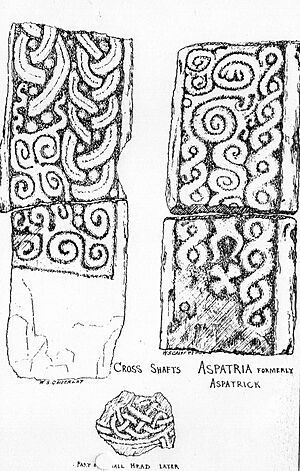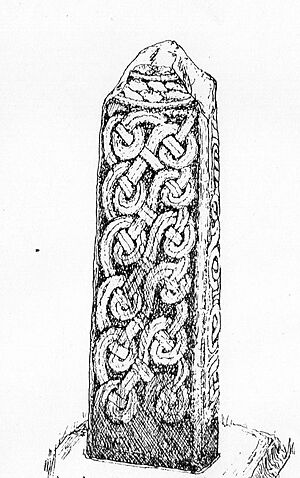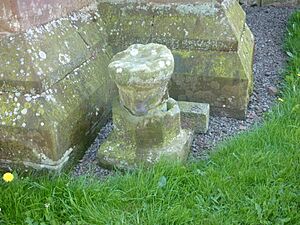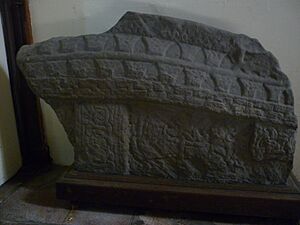St. Kentigern's Church, Aspatria facts for kids
Quick facts for kids St Kentigern's Church |
|
|---|---|
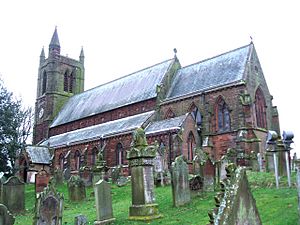
St Kentigern's Church from the southeast
|
|
| Lua error in Module:Location_map at line 420: attempt to index field 'wikibase' (a nil value). | |
| OS grid reference | NY 325 398 |
| Location | Aspatria, Cumbria |
| Country | England |
| Denomination | Anglican |
| Website | St Kentigern, Aspatria |
| History | |
| Status | Parish church |
| Dedication | Saint Kentigern (Saint Mungo) |
| Architecture | |
| Functional status | Active |
| Heritage designation | Grade II* |
| Architectural type | Church |
| Style | Norman, Gothic |
| Groundbreaking | 19th century |
| Completed | 1848 |
| Specifications | |
| Materials | Body sandstone Tower sandstone with sandstone quoins, Roof green slate |
| Administration | |
| Parish | Aspatria |
| Deanery | Maryport |
| Archdeaconry | Carlisle |
| Diocese | Carlisle |
| Province | York |
St Kentigern's Church is a beautiful old church in the village of Aspatria, Cumbria, England. It is an active Anglican church, meaning it belongs to the Church of England. This church is very special, so English Heritage has given it a Grade II* listed building status. This means it's an important historic building. The church is named after St Kentigern, who was also known as Mungo, meaning "good friend." People believe he preached near a Holy well here in the 6th century.
Contents
History of St Kentigern's Church
After the Norman Conquest, the church was given to the prior and convent of Carlisle. This gift was confirmed by kings Henry II and Edward III.
The current church building stands where an older Norman church used to be. That Norman church was too small for the growing number of people in the area. Before that, there might have been even older wooden buildings from the Saxon times (around the 6th or 7th century).
The first stone for the new church was laid on July 23, 1846. It was a big ceremony with Masonic traditions. The Bishop of Carlisle officially opened the church on June 6, 1848. The whole building project cost £3,180, which was a lot of money back then! Half of it was raised by people donating money.
Exploring the Church's Design
Outside the Church
The church is built in an early English style. It looks like a Victorian town church. It has a main area called a nave, side sections called aisles, a chapel, and a chancel (the area around the altar). There's also a south-facing porch and a vestry (a room for clergy). At the west end, there's a tall tower with parapets and pinnacles at the top.
The church is made from local red sandstone, and its roof is covered with green Cumberland slate. The architects, Messrs. Travis and Mangnall, designed the new church. They were clever and used some parts of the old Norman church in their new design. For example, they used the old Norman doorway as the entrance to the vestry. They also kept and fixed up the Musgrave chapel.
Inside the Church
Inside, the main area (nave) is about 22 meters long and 12.2 meters wide. The chancel is 9.2 meters long and 4.9 meters wide. The pulpit, where sermons are given, is made of stone. The pews (church benches) are open and all look the same.
The church has beautiful stained glass windows. These windows show scenes like the Crucifixion, the Resurrection, and the Ascension. One window in the Musgrave Chapel shows the Musgrave family's coat of arms.
Over the years, more things were added to the church. In 1875, a local person named Sarah Langcake paid £200 for a new organ. A year later, Mrs. Powell, whose husband used to be the vicar, paid £120 for a clock in the tower. She also helped pay for one of the bells. In 1898, the local people, children, and Sir Wilfrid and Lady Lawson worked together to get eight new bells for £598. In 1899, a heating system was installed for £220.
Ancient Treasures of the Church
The Baptismal Font
The font is a special bowl used for baptisms. We don't know exactly when it was made. Long ago, during the Reformation, it was damaged and thrown away. Later, skilled craftsmen fixed it. They filled holes with plaster and added new decorations and pillars. They also covered the top with lead.
The font is almost one meter tall and about sixty centimeters wide. It has interesting carvings. On one side, there's a winged demon with its head down and a curled tail. This design is thought to show that evil is driven away when a child is baptized. The font was moved in 1903 and now stands in the Baptistery.
Old Crosses and Stones
The church has several old crosses and grave stones. Many of these were studied by the Rev. William Slater Calverley, who was a vicar here. Some pieces are in the churchyard wall, and others are in the vestry. One fragment has a swastika symbol, which was an ancient sign of eternity. It's believed to be from the mid-fifth century.
Spiral Crosses
There are two parts of what used to be two spiral crosses. They are made of white sandstone. One piece is 1.15 meters tall and 40 centimeters wide. It has braided patterns. The other pieces show a man's body and legs, and another swastika. Some people think this represents the crucifixion of Jesus. There are nine of these stone slabs in the vestry.
The Standing Cross
This cross is very old, from before the Norman times. It's made of red sandstone and is 1.37 meters tall. The top part, called the wheelhead, is broken, but you can still see its lower part. The cross has detailed knot work carvings. On one side, there's a bound animal, which might mean that enemies cannot harm people when the cross is present.
This cross used to stand in the churchyard in its own stone base. It was later moved inside the vestry, next to the font.
Hogback Stone
A Hogback is a special type of old tombstone. It looks like a house with a curved roof, often carved to look like tiles. These stones are meant to represent the house of the dead. When the old Norman church was taken down, builders found a Hogback stone. It is 1.17 meters long and 69 centimeters high. It has a decorated ridge on top and patterns like Triquetra (a symbol of the Trinity) on its sides. This Hogback is now in the vestry.
Outside the Church Grounds
The church and its large churchyard are surrounded by a stone wall. On the south side, there are beautiful main oak gates. These gates were carved in 1933 by Mr. Joseph Berwick and his daughter Alice. They are now a Grade 2 listed structure because of their special history and design.
On the north side, you can find an ancient Dovecote, which is also Grade 2 listed. A dovecote is a building where pigeons or doves were kept. This one is probably the oldest building in the area!
On the east side of the church, there's a copy of the Gosforth Cross. This was carved under the direction of the Rev. William Slater Calverley.
Near the northern end of the churchyard is St. Kentigern's Well. This well still has water. It's believed that St. Kentigern and other missionaries preached here, and this might have been where new Christians were baptized. It's said that all churches named after St. Kentigern have a well nearby.
The earliest house for the vicar was built in 1714. It was a simple, small building. It was taken down in 1868 and replaced with the current building. In the 1990s, a new vicarage was built in the garden.
Past Vicars of St Kentigern's Church
Here is a list of the vicars who have served at St Kentigern's Church, Aspatria. Their names are recorded on a special tablet inside the church.
- 1174 Benedict
- 1200 Adam
- 1292 Bartholomew de Kertling
- 1309 Alan de Horncastle
- 1318 Richard de Melburn
- 1333 Nicholas de Stoveton
- 1333 Robert Bully
- 1357 Adam Deincourt
- 1357 Roger de Ledes
- 1358 Adan de Alneburgh
- 1380 William de Arthuret
- 1385 Robert de Pontefract
- 1385 Adam de Fonward
- 1397 John Mayson
- 1405 Thomas de Brampton
- 1424 William Sandes
- 1462 John Yodal
- 1474 William More
- 1489 Thomas Yong
- 1490 John de Ireby
- 1565 Edward Mitchell
- 1565 Anthony Thwaites
- 1578 Lancelot Dawson
- 1610 William Orbell
- 1617 Mathew Braddel
- 1639 Thomas Warwick
- 1661 Francis Palmer
- 1686 Richard Holme
- 1695 George Fleming
- 1703 Robert Hume
- 1706 David Bell
- 1729 John Brisco
- 1771 William Gilpin
- 1793 William Fernyhough
- 1815 John C. Gilbanks
- 1837 Edward Thompson
- 1838 Edward Salkeld
- 1872 L. T. Shipman
- 1879 T. W. Powell
- 1885 W. S. Calverley
- 1898 F. L. H. Millard
- 1905 Thomas Hackworth
- 1921 J. L. Crawley
- 1928 A. H. Hodgson
- 1939 Henry Whitley
- 1954 Vernon D, Clark
- 1963 John Needham
- 1972 G G Douglas
- Brian Rowe
- Clive Shaw
- Tim Herbert
See also
- Grade II* listed buildings in Cumbria
- Listed buildings in Aspatria


